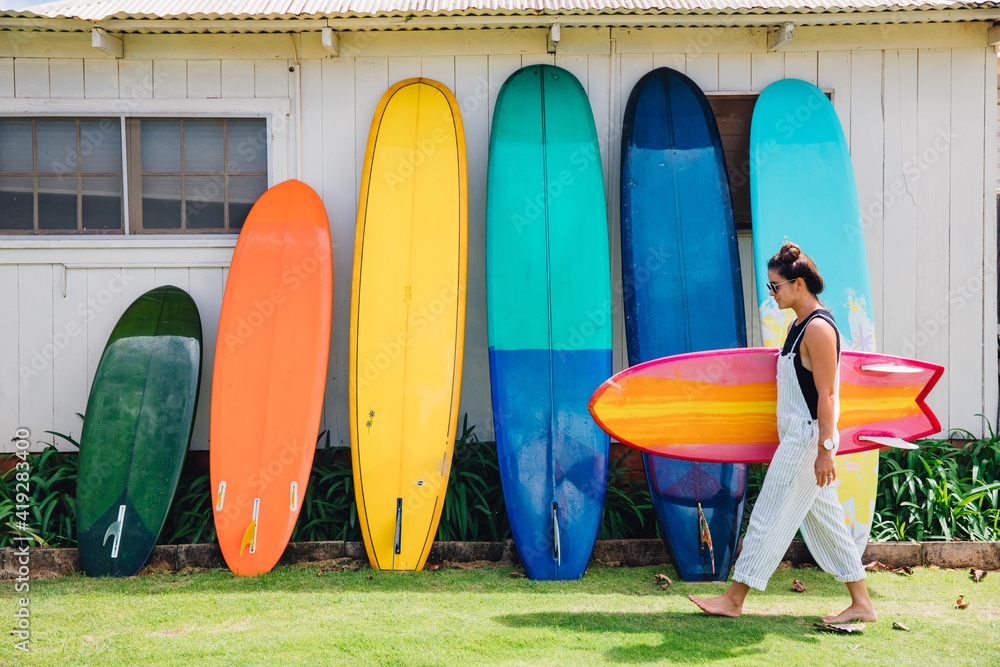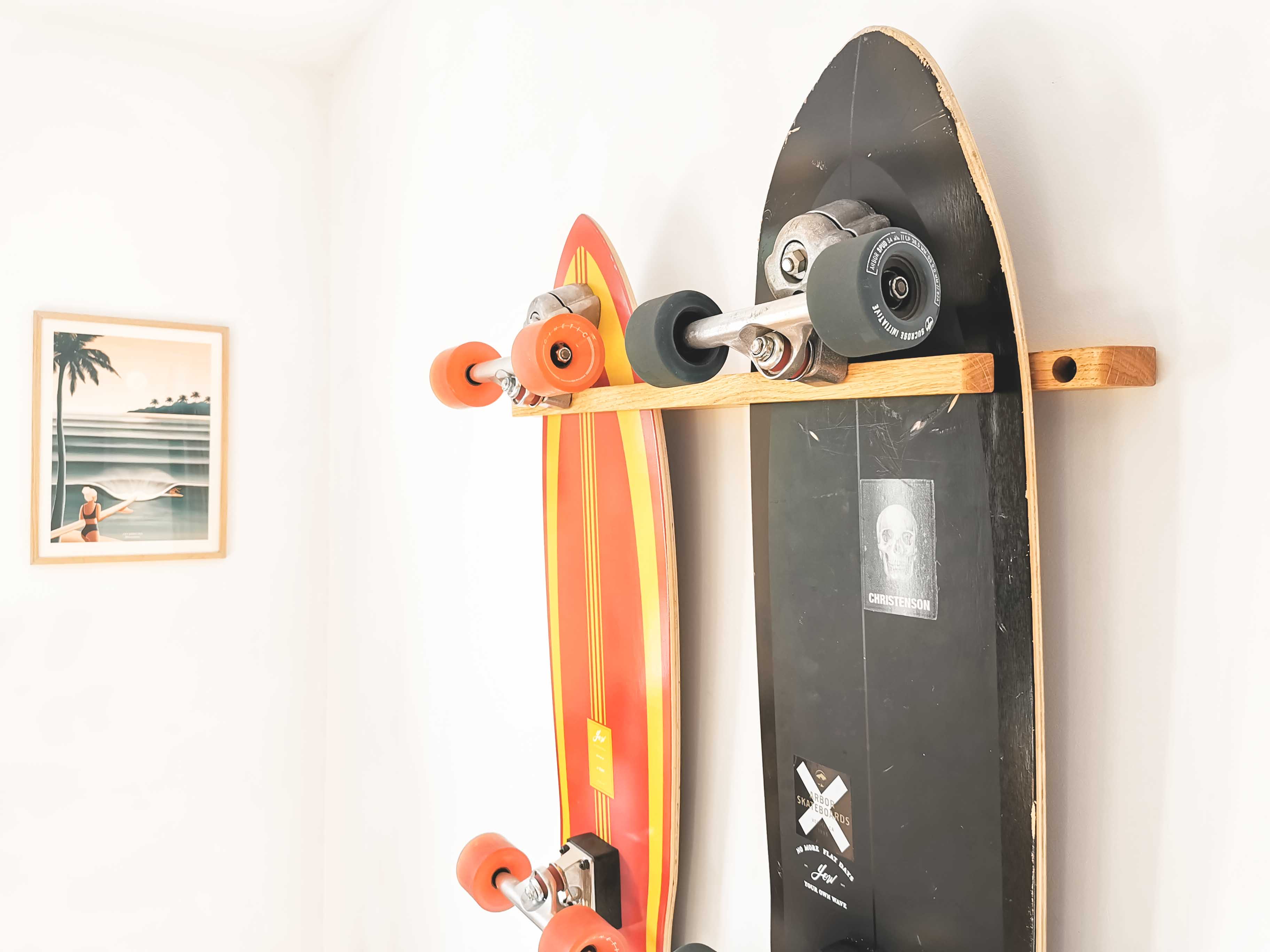Outline
The general shape of a surfboard, viewed from the front or back, is called the outline. It is thanks to the outline that we recognize the different types of surfboards: shortboard, midlength, longboard, gun, retrofish, etc.
- Shortboard: The shortboard outline is short and tapered, with a pointed nose and a wide tail. This type of board is ideal for experienced surfers who want to surf powerful waves.
- Midlength: The midlength outline is longer and wider than a shortboard, with a pointed nose and a more rounded tail. This type of board is ideal for surfers of all levels who want to surf medium-sized waves.
- Longboard: The longboard outline is long and wide, with a round nose and a wide tail. This type of board is ideal for beginner and intermediate surfers who want to surf soft waves, or experienced surfers who want to do dancing and nose rides.
- Gun: The gun outline is very long and tapered, with a pointed nose and a very thin tail. This type of board is ideal for experienced surfers who want to surf very powerful waves.
- Retrofish: The retrofish outline is a combination of the outlines of the shortboard and the longboard. This type of board is ideal for surfers of all levels who want to surf waves of all sizes.
Width
The width of a surfboard is adapted to the surfer's skill level, the power of the waves, and the surfing style.
- Skill level: Beginner and intermediate surfers need a wider board for more stability. Experienced surfers can choose a narrower board for more maneuverability.
- Power of the waves: Surfers who surf in powerful waves need a wider board for more stability. Surfers who surf in small, soft waves can choose a narrower board for more maneuverability.
- Surfing style: Longboard surfers need a wider board for more stability. Shortboard surfers can choose a narrower board for more maneuverability.
Length
The length of a surfboard is also an important factor to consider. Just like the width, it is adapted to the level and the size of the waves. The bigger the waves, the longer the board needs to be to have speed at the paddle and stability at the takeoff (like guns). But it is also a way to have more stability for a beginner or to surf very small waves. On the other hand, a small board like shortboards will be interesting in medium to large waves, to get into the curl and perform radical maneuvers.
Here are some standard length ranges by board type:
- Shortboard and step-up: 5'6" - 7'2"
- Retrofish: 5'10" - 8'0"
- Midlength: 7'0" - 8'6"
- Longboard: 8'0" - 10'0"
- Gun: 9'0" - 12'0"
Thickness
The thickness of a surfboard is the characteristic that will most influence the ability of the board to float the surfer (thanks to Archimedes' thrust). The thickness is generally distributed over the entire length of the board, while keeping the thickest part under the body, so in the middle or a little at the front of the board to favor the wave takeoff.
A thick board offers comfort when paddling and makes it easier to get up on a wave, which is beneficial for beginners, soft waves or very large and fast waves for guns or step-ups. A thinner board will be less stable but more responsive.
Rails
The rails are the part of the board that digs into the wave face when the surfer leans in to make a turn. They can be round, which forgives many mistakes but decreases the responsiveness and speed of the board. They can also be pointed or "pinched", which makes the board more responsive and faster, but therefore more technical to surf.
In relation to the thickness of the board, the thickness of the rails will again affect the buoyancy and therefore the stability of the board in a curve.
Tails
The back of the board, or tail, influences the grip of the board and therefore its ability to perform maneuvers. In general, the typology of each tail is defined by its use and the size of the wave. Here are some principles, although anything can be used:
- Small waves: squash, square, and round tail
- Medium waves: diamond, baby squash, and round pin tail
- Hollow and powerful waves: pin tail, and baby swallow tail
Fins
Surf fins provide directional stability, directional control, and hold in the wave. They contribute to the stability and control of the board, allowing surfers to stay up and perform maneuvers with precision. Fins also affect speed generation and can be adjusted to suit the surfing style and specific wave conditions. In summary, fins are essential for the control, maneuverability, and overall performance of a surfboard.
Single Fin (Central Fin) :
- Advantages: Speed and fluidity in long turns, straight-line stability, ideal for powerful and hollow waves.
- Disadvantages: Lack of maneuverability and control in small waves, difficulty generating speed in soft sections.
Twin Fin (Two Fins) :
- Advantages: Great maneuverability and responsiveness, excellent for small waves and tight turns, fast speed generation.
- Disadvantages: Lack of stability and control at high speed, less suitable for large waves and hollow sections.
Thruster (Three Fins) :
- Advantages: Balance between maneuverability and stability, versatile in a wide variety of wave conditions, allows tight and fast turns while maintaining stability.
- Disadvantages: Less speed than two-fin setups, less freedom in radical turns compared to a twin fin.
Quad (Four Fins) :
- Advantages: Excellent speed and hold in soft sections, good acceleration out of the wave's trough, excellent directional stability.
- Disadvantages: Less maneuverability and pivot than three-fin setups, less suitable for hollow waves.
- Depending on the location of the two rear fins, the "sides", the behavior will be different. Very spaced sides and close to the front fins will offer a behavior closer to the twin fin, while very recessed and tight sides will approach the behavior of a thruster.
5-Fin (Five Fins) :
- Advantages: Versatile setup that allows you to change the behavior of the board, being able to be used as a thruster (three fins) or quad (four fins), adaptability to different wave conditions.
- Disadvantages: Can be more complex to set up and adjust than three- or four-fin setups, not as specialized as specific setups.
Of course, these explanations work in general, but depending on the shape made, it may be wrong. For example, some big wave surfers use twin fin guns, while this is generally not considered stable in powerful waves. There are also non-conventional fin setups, such as the bonzer, the double US box (two single fin fins side by side), the asymmetrical setup (twin on one side and quad on the other), etc.
Rocker
The rocker is the curve of the bottom of the surfboard, which is more or less continuous and pronounced from the back to the front of the board. The flatter it is, the faster the board will be. The more pronounced it is, the more controllable and maneuverable the board will be :
- A pronounced rocker at the front makes it easier to take off in hollow and powerful waves.
- A flat rocker at the front makes it easier to enter soft waves.
- A more pronounced rocker at the tail allows for tighter and more controlled turns.
- A flat rocker at the tail promotes speed during turns.
Concaves
The bottom of a surfboard is never perfectly flat. Shapers apply concaves to it in order to give different reactions to the board during turns :
- A single concave offers more flat-out glide and speed during turns.
- On the other hand, the Vee offers an ease of transition from one rail to the other, but decreases speed.
- A double concave offers the lift and speed of the single concave while allowing a little more ease of transition from one rail to the other.
These concaves are generally combined with each other along the entire length of the board in order to take advantage of their different advantages and disadvantages. They also depend on the surfer's style of stance :
- A surfer who surfs mostly on his back foot will find it easier to turn a board and will probably prefer a board with a single or double concave.
- On the other hand, a surfer with a front foot stance may need a little lift on the tail in order to facilitate the transition from rail to rail.
Conclusion
In this article, we have discussed the different factors that go into designing a surfboard. We have looked at the outline, width, length, thickness, rails, tail, and fins. We have also seen how these factors can be combined to create different types of surfboards.
It is important to understand all of these factors when choosing a surfboard. However, it is also important to remember that the best way to choose a board is to talk to a local surf shop or shaper. They will be able to help you find the perfect board for your needs and skill level.


